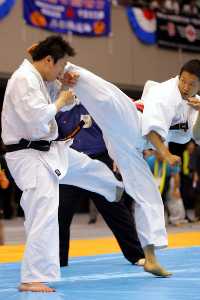
Waza (technique), and its precise execution, is such a vital aspect of the martial arts in that it allows a smaller, physically weaker person to prevail against a larger, stronger antagonist. Still, in spite of this statement, physical strength has its place, and under certain circumstances can go a long way for the practitioner. This is in no way to discredit the effectiveness of using proper form in techniques, nor should this principle ever be dismissed. But I believe that any physical endeavor, including martial arts training, should include a regimen of weight training to develop strength.
At one time, strength training with weights was considered taboo for the athlete. With the exception of football players, competitive weightlifters and bodybuilders, athletes were strictly advised to avoid lifting weights. One myth attributed to weight training is that it compromises speed and flexibility - two sought after qualities in the martial arts. Flexibility is the result of proper stretching, which should be done daily and is especially recommended before and after a martial arts session. Speed is acquired through training for that capacity, and can be developed alongside of a strength training routine without one interfering with the other.
During Okinawan karate's early development, ishi-sashi were used in a fashion similar to using dumbbells. These hand-held stone devices were carried as the practitioner performed kata and various strikes. In the 60s, martial arts historian Donn Draeger was one of the first to suggest a weight training program for judo players. In addition to Draeger, Chuck Norris and Bruce Lee were advocates of weight training for martial artists at about the same time.
Besides making muscles grow, weight training causes bones to become denser, offsetting the possibility of osteoporosis late in life (prevalent in women). Added muscle also creates a more efficient metabolism, capable of burning fat at rest (as opposed to a cardio workout, which only burns fat while training). Today, it is a rare athlete that doesn't employ some kind of progressive resistance training.
Labels: Bruce Lee, Chuck Norris, competition, Donn Draeger, exercise, judo, training






